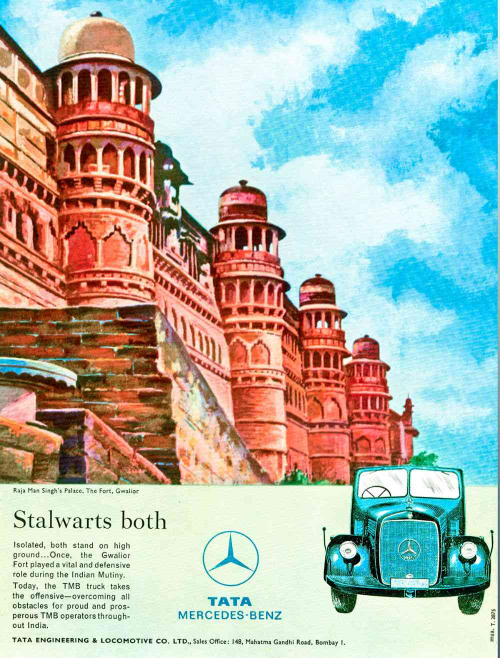Kanika S
This essay explores the role of business archives in serving the business interests, and how history – distinct from the past – is created and revisions to it (or alternate interpretations) are prevented. Archives have become an important and inexpensive corporate asset in today’s world that shape a corporate identity by providing a narrative using selective management actions and decisions taken in the past. Ineke Deserno (2007) conducted a review of world’s 50 largest MNC’s public websites and corporate archives and observed that companies that have come under public flak for past actions – for example, cooperation with the Nazi regime – open their archives to the public in order to rebuild public confidence and trust.1 How a business chooses to deal with an inconvenient past, of course, varies across time and geography. In this particular essay, I have chosen to focus on Tata Group and draw conclusions based singularly on one Indian business group.

Value of Business Archives
In the introduction of Everybody’s Business: An Almanac, its editors Milton Moskowitz, Robert Levering and Michael Katz say this: “Corporations, like people, are often better understood by looking at their past. In the business world, where eyes are usually fixed firmly on the road ahead, this exercise is seldom performed.”
Wherever such an exercise has been performed, and wherever professionally managed archives have been created, history is being drafted to pave the way to the future.2
Archives are supposed to contain the primary sources of historical records and not derivate works. They’re considered an important source to verify or discredit any claims. A corporate archive can help businesses tell their stories and create brand identities with a verifiable past of their own. In this context, it becomes important to understand and critically evaluate what is preserved in corporate archives and what is not.
The History & Historiography of TATA
The Tata Group was founded in 1868 by Jamsetji Nusserwanji Tata with the establishment of a trading company called Tata & Sons, with a capital of INR 21,000 (pegged at USD 58 million at 2019 prices level). Today the group is one of India’s largest enterprises comprising of 30 companies with operations in over 100 countries and annual revenues of over USD 110 billion. The group’s stated mission is as follows: ‘To improve the quality of life of the communities we serve globally, through long-term stakeholder value creation based on Leadership with Trust’.
JN Tata’s first major industrial venture was in 1877 with the founding of a cotton textile mill in Nagpur. Since then Tata group has expanded its business portfolio to software, steel, power, automobiles, aviation, tea, broadcast & communication, luxury hospitality, chemicals, insurance, retail, telecommunications and water. More recently, the group has acquired global iconic brands like Jaguar, Land Rover, Tetley and Corus. It has been a pioneering business house in the sense that it laid the founding stones of industries such as steel, luxury hospitality and aviation in India.
Tata’s philanthropic history is said to be initiated by JN Tata in 1892 with the founding of JN Tata Endowment Fund; he bequeathed 1/3rd of his personal wealth for the creation of the present day Indian Institute of Science in Bangalore. His sons, Dorabji Jamsetji Tata and Ratanji Jamsetji Tata, continued in their father’s footsteps – continued providing monetarily for various purposes, and later willed a part of their personal wealth to Trusts established in their names. Over the course of the last century, many other Trusts have also been instituted in the names of other Tata family members.
The Tatas have attracted the interests of numerous historians. Not just biographical accounts and individual memoirs, a good number of historical accounts of the group and even extensive accounts of specific industries with Tata’s involvement are widely available. Additionally, there is a plethora of literature that doesn’t necessarily revolve around Tatas but contain significant reference to them. However, amidst such extensive historiography of the Tatas, there is very limited availability of critical historiography – with the notable exceptions of Markovits C. (2008) The Tata Paradox. In: Merchants, Traders, Entrepreneurs; Palgrave Macmillan, London, and Dilip Simeon’s seminal book, The Politics of Labour Under Late Colonialism – Workers, Unions and the State in Chota Nagpur 1928-1939; published in 1995.
This essay attempts to highlight some of the reasons behind this paradox – the lack of critical scrutiny in the discipline of History, and how Tatas are in fact making their own history. It also draws attention to a few inconvenient historical accounts – or unarchived histories – that I have been able to extract from the resources available to me.
Creating History
In the following sections, I seek to highlight how such historical narratives are commissioned to historical accounts. In doing so it is interesting to note how history is not only written by the victors but by the rich and powerful without an apparent war.
Organising Archives
A crucial resource for the production of the aforementioned extensive historiography on and of the Tatas are the sources. The Tatas have also been pioneers in setting up India’s first business archives called the Tata Central Archives (TCA) in January, 1991 in Bombay (it was moved to Pune in 2007). In their own words, TCA is “a repository of important documents – correspondence, photographs, awards, trophies, medals, citations, paintings, video and audio clips, etc., amongst other material that relate to the genesis as well as development of the Tata organisation and its manifold activities.” In a way, TCA marks another achievement in its long list of pioneering works. The existence of physical correspondence with leaders of Indian National Congress, such as letters exchanged between Dadabhai Naoroji and MK Gandhi, help Tata group lay claim to wider relevance such as the history of India’s industrialisation and nationalism. In fact, the Archives have gained such competence levels that they now offer support (through workshops and training programmes) to other business houses that might be interested in starting their own archives.3
The Archives continue to position itself as a neutral collection of traces of the past from which history can seemingly be recovered. For instance, their website declares that “history lies treasured in these carefully preserved files at the archives” – the common and problematic tendency to construe equivalence between history and traces of the past. But what is even more problematic than this is the history of careful destruction of historical sources that can in anyway be used to challenge the singular historical narrative of the Tata’s business empire.
Prevention of alternate historical readings
Frank Harris published one of the first books on JN Tata’s life back in 1925; he called it a chronicle rather than a biography because his sources were not credible enough, in his opinion, for that kind of qualification.10 According to Arun Kumar (2016), Harris acknowledged that there was very little source material available to him while working on this book. In fact, his account is majorly based on JN Tata’s personal papers (in English) and his son Dorabji’s oral accounts, which were in turn procured from Dinshaw Wacha who had written an earlier account on JN Tata. Interestingly, in the book Tata: The Evolution of a Corporate Brand, Morgen Witzel calls Harris’s book a ‘hagiography’ which indicates how selective the sources made available to him must be.4,5 In their bibliographical survey, Benjamin and Rath (2005) have claimed that the practice of destruction of source material by business families as a major reason for scant work on business history in India. Even the sources used by Wacha and Harris were destroyed after Harris’s book was complete.5,6,7,10 Later another book on JN TATA’s life was written using his letters, articles and diary (Saklatavala and Khosla) but the sources are reportedly not available for research for reasons unclear.6 Whatever historical records have survived are not easily available for research for fears that they might ‘result in adverse remarks’.5
Much like JN Tata’s writings, Ratanji Tata also directed that his records be destroyed upon his death as part of his will.6 Naval H Tata also followed suit and willed that even his written records be burned when he dies.5 This practice has in effect prevented their records from becoming available for research to the public. Therefore, there has been a tendency to present a singular, often white-washed narrative of the past; the history so written is actively sought to be controlled and prevented from any unkind alternate interpretations. The gains from such institutional dishonesty are immense – for one, it helps those in power evade any accountability for their past actions. It brings the business families a clean slate in every generation to don whatever ideological avatar that might be in the position to accrue them the most profits.
Anxiety over access to information to outsiders
Another way in which business history on Tatas is controlled is through restrictive practices of access at TCA. Arun Kumar (2016) writes about how researchers need to make a presentation to the Archivist to inform purpose and provide a rationale for the same before access is granted. This is claimed to be a practice at TCA on account of unknown ‘bad past experiences’.6 There are also uneven restrictions on photocopying the Archive material, and catalogues and private papers are unavailable to the public.6 Therefore, access to source material on Tatas for the purpose of writing history is a tightly controlled process made possible through TCA. Such scuttling practices enable construction of some particular and desired historical narratives, while erasing others.
Silencing Opium Trade out of History
During colonial rule in the subcontinent, the British had monopolised production of opium in their Indian territory which was then exported to China to raise capital to foot the bill for tea imports from China. Opium trade was banned in China initially and was illegally smuggled in by the White colonial masters from Bengal. Two bloody Opium Wars were fought between the British and the Qing Dynasty in the 19th century, effects of which are still felt in terms of China’s constrained relations with the West.
What is missing in the glorious biographies and chronicles of Tata family is their role in this very exploitative opium trade – sure, one would find mentions of it in media now and then, but if one looks for credible evidence in the form of published papers or books, there is hardly any after 2003 (Worden’s paper: The Role of Religious and Nationalist Ethics in Strategic Leadership: The Case of J. N. Tata8). Even literature that does talk about this says so only passingly, with an attempt to normalise it as any other commodity. As luck would have it, Hong Kong’s Legislative Council has uploaded official recordings of to a council meeting held on 25th March, 1887 that proves that Ratanji Dadabhoy Tata, “of the firm Tata & Co.,” was one of representatives to present a petition “for and on behalf of the Opium Importers and wholesale Opium Merchants of the said Colony” in the Legislative Council.9 Snapshot given below for reference.

This is interesting because Tatas have over years built a brand image of being a torchbearer of ethical conduct in business. So much so that time and again JN Tata is eulogised as a very giving, nationalist and socially conscious businessman who laid the foundation for Tatas’ much talked about philanthropic efforts. For instance, in the book For the Love of India: The Life and Times of Jamsetji Tata by RM Lala, much inferences have been drawn from letters from JN Tata to Lord Curzon requesting for the bequeathing of fourteen buildings and four landed properties for the construction of IISc, Bangalore; the British expected that the Tatas would cancel this request and instead use these resources on their iron and hydroelectric projects; but that did not happen and the land was granted to JN Tata by Lord Curzon posthumously10. This incident is presented and constructed as one where JN Tata ‘stood up to’ the erstwhile colonial powers and performed an act of nation-building.
To construct institutes of higher learning such as IISc in 1900s can hardly be an endeavour of ‘national character’ in terms of serving the masses of the country with literacy rates of 5.4% (Census Report). Its research outcomes have been clearly underwhelming in terms of either societal impact or international prestige. Instead, what it created was another funnel of upward mobility for the Dwija castes to interact with other elites in the world and negotiate more power. IITs, IIMs, JNUs followed suit. So much so that today anything that is deemed of “national” character has very little to do with the lives of masses that inhabit the lands on which India lays its claims, ‘India’ and ‘Indian’ have become carefully constructed identities for adoption whenever one interacts with the outside world. This has very little to do with how life is lived in the Indian territories where these identities have not been uniformly adopted till date. In my experience, one is more likely to identify with such identities – and the strength of such convictions are also strong – if one has been socialised in such institutions of “national character” constructed in the last century. Nationalism has been carefully constructed by Indian National Congress to have a halo – its currency is so much that it has become a favourite identity of the exploitative ruling class.
Coming back to the point, even in the sympathetic account of the man, Lala has chosen to avoid any mention of his involvement with the opium trade that might have impeded the construction of an acceptable, desirable historical narrative. This erasure helps to propagate the Tata brand as one which is of distinctly high moral standards and enables their claim to an ‘ethical’ identity.
Colonial profiteer yesterday, Nationalist today
There is sufficient evidence of correspondence at TCA between members of the Tata family and MK Gandhi; in fact, even their website doesn’t fail to use Gandhi to construct a nationalist narrative for the family and by extension the corporate brand.3 There is also a large amount of historiographical accounts to highlight the involvement of Tatas with Gandhi. Interestingly, what is hard to find are instances wherein the Tatas worked in cahoots with the colonial rulers that could possibly provide a challenge to the nationalistic narrative. One such instance is the construction of an ambitious hydroelectric project in 1910s on the banks of Mula river in Mulshi district in Pune, Maharashtra. Here, with British support, the Tatas enabled land grabs under the draconian land acquisition laws and perpetrated large scale eviction of agricultural labourers (most of them tenants) from the region on promise of compensation.11 The displaced, jobless masses organised themselves to protest the high-handedness of these actions. The protest evolved into India’s first Satyagrah and received some support from Gandhi who chided the Tatas for forced eviction in a letter.
Towards the end of the decade, Tata Electric Supply Company was founded to lead the construction of a series of dams in Mulshi Petha to provide for the electricity needs of group industries.6,11 This marks in some way the beginning of transition of the Maharashtra region from a wholly agrarian economy to an industrialised one. This led to submergence of about 52 villages and thousands of acres of agricultural land affecting the Malva community.12 Eventually the company officials also joined British forces to aid the forced eviction of the peasants. This led to the emergence of the Mulshi Satyagrah under the leadership of Pandurang Mahadev Bapat, who came to be called Senapati Bapat.12 The movement found support from Gandhi in 1921 in a speech before the Congress held at Vasai: “what is the value of all boons that the Tata scheme claims to confer upon India, if it is to be at the expense of even one poor man?”12,13, 14
After running for four years, the movement eventually failed, and many communities ended up displaced and dispossessed. It was country’s first organised social movement against displacement, caused by a ‘pioneering’ project of Tatas. In the attempts to create history, the latter gets celebrated while the struggle of large communities is erased by omission and silence. The past is only remembered, in such a scenario, by concerned activists, historians, or second generation survivors of the victims.
 JRD Tata receiving Bharat Ratna from the President of India, 1992
JRD Tata receiving Bharat Ratna from the President of India, 1992
Conclusion
The focus on creation of history in this essay is intended to outline ways in which historical narratives can be constructed by powerful elites while seeming to preserve organisational history. It also seeks to challenge the claims propagated by the house of Tata that their endeavours are part of the building of modern Indian nation, its industries and society. Their historiography tells only half the story. Their pioneering project of TCA aids the production of a past to ensure that only their story stands empirical scrutiny as time goes by and any revisions to it are eventually made impossible.
~
References
1. Deserno, Ineke. (2010). “The value of international business archives: The importance of the archives of multinational companies in shaping cultural identity”. Archival Science. 9. 215-225. 10.1007/s10502-009-9106-1.
2. Anderson, Harold P. (1982). Business Archives: A Corporate Asset. The American Archivist, Vol. 45, No. 3, Business Archives: A Special Issue.
3. Tata Central Archives, Website: https://www.tata.com/newsroom/treasures-from-the-past-tata-central-archives
4. Morgen Witzel, Tata: The Evolution of a Corporate Brand (book)
5. Benjamin, N., & Rath P. N. (2005). Modern Indian business history: a bibliographic survey. Gokhale Institute of Politics and Economics, Pune available at http://www.gipe.ac.in/pdfs/working%20papers/wp6.pdf.
6. Kumar, Arun (2006). Making History: Archives, Historiography and their Silences.
7. RM Lala, For the Love of India (book)
8. Worden, S. Journal of Business Ethics (2003) 47: 147. https://doi.org/10.1023/A:1026050230808
9. http://www.legco.gov.hk/1886-87/h870325.pdf
10. Preface, For the Love of India, R.M. Lala
11. Cashman, Richard I. (1975). The Myth of the Lokamanya: Tilak and Mass Politics in Maharashtra. University of California Press.
12. Vora, Rajendra. The World’s First Anti-Dam Movement: The Mulshi Satyagraha, 1920-1924.
13. D G Tendulkar. Mahatma Volume 2: Life of Mohandas Karamchand Gandhi. Publications Division Ministry of Information & Broadcasting
14. http://thebookreviewindia.org/environmental-politics-and-indian-nationalism/
~~~
Kanika S is an MBA grad and an engineer by training.










